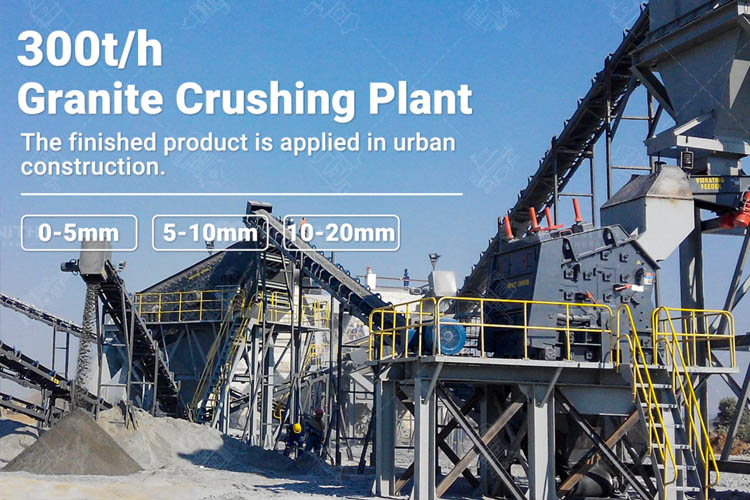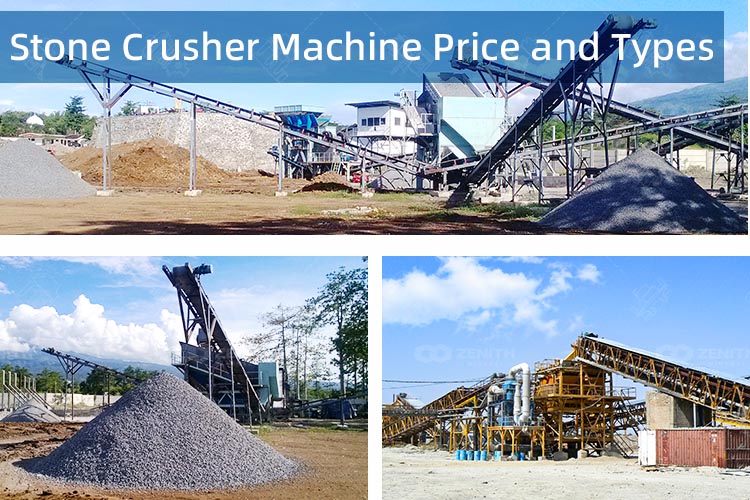Granite is the main component of the continental crust. It is widely distributed, hard and wear resistant. It is a high-quality sand making material. The machine-made sand made from granite is also famous in the construction field.
To process granite into suitable particle size, we need suitable granite stone crushing machine. In the following part, we introduce different types of granite stone crushing machine and how to choose suitable one.

Granite is a kind of volcanic rock formed by the cooling condensation of magma below the surface. It is widely distributed in the world and has rich reserves, and is easy to exploit. It can provide continuous and stable raw material supply for the production of machine-made sand.
Granite has uniform structure, hard texture, and its appearance color can be maintained for more than a hundred years. The machine-made sand processed from granite is solid and has strong compression resistance, which can meet the requirements of highway, railway and other important projects for high-quality machine-made sand.
The crystalline combination of granite is very tight, not easy to weather, corrosion resistance, wear resistance, is a good quality corrosion resistant material. The sand and gravel aggregate processed by it is more resistant to wind and rain, and is a high-quality raw material for outdoor buildings.
Due to the high quality of granite, the machine-made sand made from granite is very popular in the field of sand and gravel. And due to its high hardness, the choice of granite stone crushing machine should be careful.
In addition to choosing the right manufacturers, we should also choose the right products. For example, impact crusher and hammer crusher are not suitable for processing granite, so as to avoid the frequent replacement of subsequent wear parts that will delay production and increase costs.
Granite stone crushing machine can be divided into three categories according to the feed and product particle size:
Coarse crusher: from 1500~500mm to 350~100mm;
Medium crusher: from 350~100mm to 100~40mm;
Fine crusher: from 100~40mm to 30~10mm.
1) Jaw crusher
Jaw crusher is the most commonly used coarse crusher. It is not only used for hard rocks such as granite, but also basically used for coarse ore crushing, both soft and hard. The manufacturing process of jaw crusher is also relatively mature in China and abroad, so in the field of coarse crushing, jaw crusher is the most commonly used granite stone crushing machine.

Advantages: simple structure, reliable operation, light self-weight, cheap price, various models, small overall dimensions, large size of feed inlet (up to 1m), simple maintenance, and economic operating costs.
Disadvantages: The lining plate is easy to wear, and the content of needle and flake in the product is high. Generally, feeding equipment is required.
2) Gyratory crusher
Gyratory crusher and jaw crusher are two kinds of commonly used coarse crushing equipment. Gyratory crusher is often used to crush materials with various harnesses, but it is not suitable to break cohesive ores.
Advantages: compared with jaw crusher, gyratory crusher is continuous crushing, and its outstanding advantages are high production capacity, large crushing ratio, which can be fulfilled with ore for feeding, and direct feeding without a feeder.
Disadvantages: complex structure, high height, large volume, high plant demand, large infrastructure investment, heavy weight, inconvenient handling, high price.
1)Cone crusher
Cone crusher is definitely the most commonly used product in the fine crushing stage of granite (sometimes it is also used for coarse crushing according to the situation). It has good wear resistance and has many models, including spring type (Simmons), single cylinder hydraulic cone crusher, multi cylinder hydraulic cone crusher, inertial cone crusher, etc. However, cone crusher is also not suitable for crushing wet and cohesive ores.

Advantages: large crushing ratio, high efficiency, low energy consumption, less dust, uniform product particle size, stable operation, low failure rate.
Disadvantages: the structure and maintenance are more complex, the machine body is high and the price is expensive.
2) Fine jaw crusher
The structure and principle of fine jaw crusher are similar to those of jaw crusher. Materials are crushed in the crushing chamber composed of moving jaw and fixed jaw, which can almost meet the requirements of various materials.
Vertical shaft impact crusher
If sand making is not required subsequently, cone crusher and fine jaw crusher can also be used in the stage of fine crushing. If the particle size of the product is strictly required, vertical shaft impact crusher is generally needed for sand making and shaping.

Vertical shaft impact crusher can choose different crushing cavity types of ‘rock on rock’ or ‘rock on iron’. For granite, the hardness is relatively high, so it is not suitable to choose ‘rock on iron’ crushing cavity, because the surrounding guard plate is easy to wear, frequently replaced, and the cost of wear-resistant parts is high.
Advantages: It has the shaping function, the product is cubic, and the bulk density is large. It is a widely used sand making and shaping equipment in the market.
Disadvantages: the maintenance is complex and the cost is high. Generally, the feeding particle size of hard rock cannot exceed 45-50mm.
Since granite is hard, the crushing and sand making plant is generally divided into 3 stages: coarse crushing, medium& fine crushing and sand making (shaping) process. And the whole plant mainly consist of vibrating feeder, jaw crusher, belt conveyor, cone crusher, vibrating screen, vertical shaft impact crusher, powder concentrator( sand washer).
The production process is as followed:
Firstly, the granite stone is sent to the jaw crusher through the vibrating feeder for coarse crushing. The coarse crushed aggregate is transported to the cone crusher by the belt conveyor for medium crushing. The crushed aggregate that meets the requirements is transported to the sand making machine by the belt conveyor. The unqualified aggregate is sent to the cone crusher for re-crushing. If the finished products after sand making do not meet the requirements after screening by vibrating screen, they shall be returned to the sand making machine for further treatment. Those meeting the requirements of finished products shall be sent to the finished product stockpile after powder selection (sand washing).
Tips:
The equipment configuration of the granite crushing and sand making plant is mainly determined according to the user's granite specifications, output capacity and use of the final products. The configuration process is based on the production site. The crushing equipment has different models, and different models correspond to different production capacity, feed particle size and discharge particle size. Therefore, the crushing equipment with corresponding production capacity should be selected according to the required specifications, output and stone products to obtain the most reasonable and most economical production line.
ZENITH provides different types and models of the above mentioned granite stone crushing machine for customers to choose. And the engineers will recommend suitable type and model for you according to the specific requirements. Chat with us if you need granite stone crushing machine!

There are many types of stone crusher machines on the market. In this article, we will introduce the types and price of the stone crusher and how to select the most suitable one.

ith the exhaustion of natural sand and gravel aggregate resources and the intensification of government control, it has become an inevitable trend for the industry to replace natural sand and gravel aggregates with machine-made sand and gravel aggregates.

Depending on the granite characteristics and the detailed production needs, the whole granite crushing production line can be divided into the following parts: primary crushing, secondary crushing and the tertiary crushing.
Fill your requirements here, and we'll send the custmized solution and quotation to you by the reserved contact information.